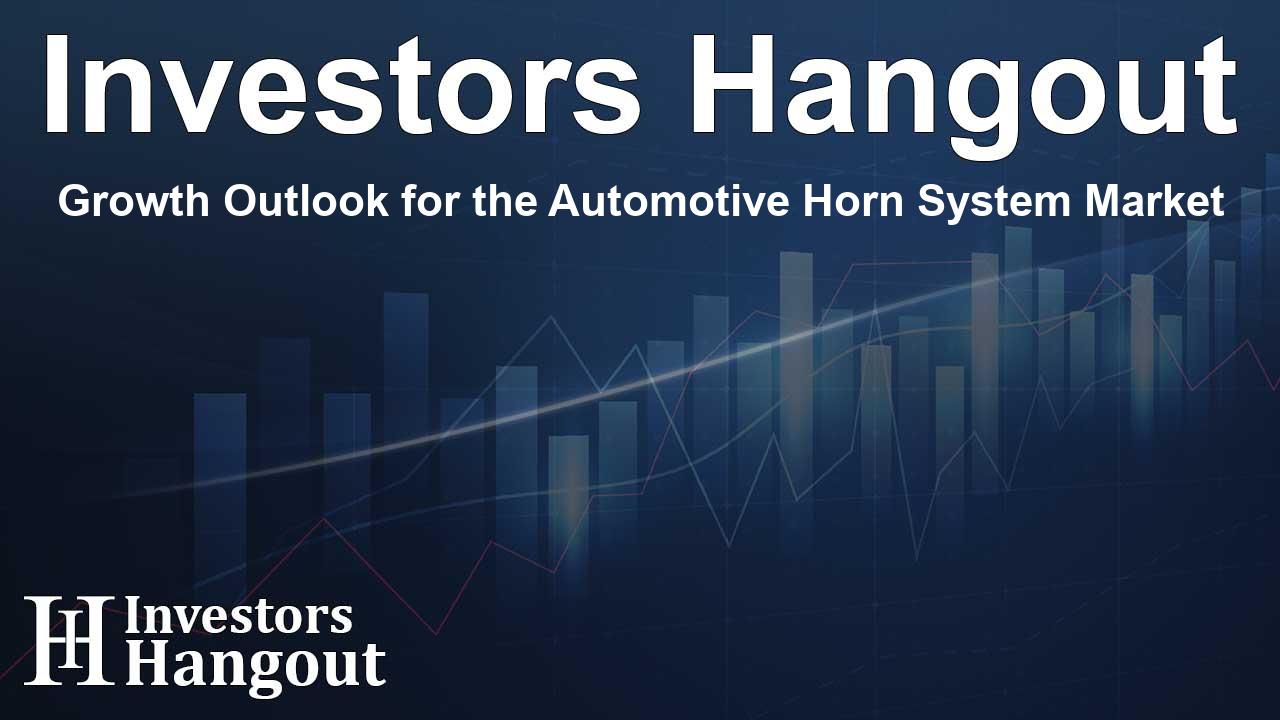Growth Outlook for the Automotive Horn System Market

Introduction to the Automotive Horn System Market
Wilmington, Delaware - A recent market report indicates a significant transformation in the automotive horn system marketplace. The study anticipates that the market, currently valued at $0.7 billion, is set to soar to $1.8 billion by the end of the forecast period in 2033, growing at an impressive compound annual growth rate (CAGR) of 9.9% from 2024 to 2033.
Key Drivers Fueling Market Growth
The demand for automotive horn systems is intricately tied to the overall growth of the automotive industry, including vehicle production and sales. As global vehicle manufacturing rises, so does the need for efficient horn systems. Innovations in technology, such as the development of digital horns and the integration of these systems with advanced driver assistance technologies (ADAS), elevate the effectiveness and reliability of automotive horns.
Rising consumer awareness regarding road safety underscores the significance of audible warning signals, further fueling demand for automotive horn systems. As consumers prioritize safety features, the market responds accordingly, adapting to these evolving preferences.
Market Segmentation Insights
Growth of Electric Horns
The electric horn segment in particular is forecasted to witness rapid growth due to its popularity among automotive manufacturers. Electric horns typically comply with stringent noise regulations while providing clear and loud sound, marking them as a reliable choice. They are designed with fewer moving parts than traditional mechanical horns, making them more durable and less prone to failure—a vital attribute for vehicle safety.
Passenger Vehicles Lead the Charge
Within the vehicle types, passenger cars hold the leading share of the market, projected to grow at a faster pace partly because they represent a larger segment of the automotive sector. With high production and sales volumes, the demand for horn systems in passenger vehicles is substantially higher compared to their commercial counterparts.
Emerging Trends and Innovations
The Horn Shape Impact
Among the various horn shapes available, trumpet horns are trending upward regarding market share. Known for their loud and distinct sound, they offer superior sound projection and are preferred for their reliability, particularly in enhancing road safety. This preference has engendered a robust demand for trumpet horns across both original equipment manufacturing and aftermarket segments.
Aftermarket Growth Potential
The aftermarket segment is poised for notable growth as vehicle owners increasingly seek to upgrade to advanced automotive horns, including multi-tone and digital options. As the average vehicle ages, the aftermarket plays a crucial role in providing replacement and upgraded horns, thereby bolstering market demand.
Regional Market Dynamics
In the regional landscape, North America is forecasted to maintain its market dominance through 2033. The well-established automotive industry, primarily in the U.S., fosters consistent demand for automotive components, including horn systems. Moreover, the region is characterized by a swift adoption of innovative technologies in automotive horn systems, further propelling growth.
Leading Players in the Market
The automotive horn system market features several key players that are pivotal to its dynamics. These include:
- Denso Corporation
- Fiamm Componenti Accessori - FCA
- Hella GmbH & Co. KGaA
- Horns Unlimited
- Klaxon Signals Ltd.
- Minda Industries Ltd.
- Mitsuba Corporation
- Robert Bosch GmbH
- Sanfeng Auto Parts Co., Ltd.
- UNO Minda Group
These market participants are constantly evolving their strategies through product launches, collaborations, and expansions to increase their market share and enhance their regional presence.
Conclusion and Outlook
The automotive horn system market landscape is set for substantial growth fueled by advancements in technology, increasing consumer safety awareness, and robust production rates in the automotive industry. Stakeholders in the industry can expect significant opportunities as innovations continue to unfold within the automotive sector.
Frequently Asked Questions
1. What factors are driving the growth of the automotive horn system market?
The key drivers include increasing vehicle production, technological innovations, and heightened consumer awareness regarding safety features.
2. Which segment of the automotive horn system market is expected to grow the fastest?
The electric horn segment is anticipated to experience the fastest growth due to its compliance with noise regulations and reliability.
3. Why are trumpet horns becoming more popular?
Trumpet horns are favored for their loud and distinct sound, effectiveness in alerting road users, and overall reliability, which enhances road safety.
4. How does the aftermarket sector contribute to market growth?
The aftermarket sector is vital as vehicle owners upgrade and replace aging components, looking for advanced horn systems to improve vehicle performance.
5. Which region is expected to lead the automotive horn system market?
North America is forecasted to maintain its dominance due to its mature automotive industry and rapid technological adoption.
About Investors Hangout
Investors Hangout is a leading online stock forum for financial discussion and learning, offering a wide range of free tools and resources. It draws in traders of all levels, who exchange market knowledge, investigate trading tactics, and keep an eye on industry developments in real time. Featuring financial articles, stock message boards, quotes, charts, company profiles, and live news updates. Through cooperative learning and a wealth of informational resources, it helps users from novices creating their first portfolios to experts honing their techniques. Join Investors Hangout today: https://investorshangout.com/
Disclaimer: The content of this article is solely for general informational purposes only; it does not represent legal, financial, or investment advice. Investors Hangout does not offer financial advice; the author is not a licensed financial advisor. Consult a qualified advisor before making any financial or investment decisions based on this article. The author's interpretation of publicly available data shapes the opinions presented here; as a result, they should not be taken as advice to purchase, sell, or hold any securities mentioned or any other investments. The author does not guarantee the accuracy, completeness, or timeliness of any material, providing it "as is." Information and market conditions may change; past performance is not indicative of future outcomes. If any of the material offered here is inaccurate, please contact us for corrections.